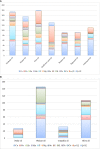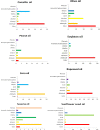Edible Plant Oil: Global Status, Health Issues, and Perspectives
- PMID: 32983204
- PMCID: PMC7485320
- DOI: 10.3389/fpls.2020.01315
Edible Plant Oil: Global Status, Health Issues, and Perspectives
Abstract
Edible plant oil (EPO) is an indispensable nutritional resource for human health. Various cultivars of oil-bearing plants are grown worldwide, and the chemical compositions of different plant oils are diverse. The extremely complex components in oils lead to diverse standards for evaluating the quality and safety of different EPOs. The environment poses great challenges to the EPO safety and quality during the entire industrial chain, including plant cultivation, harvesting, oil processing, and storage. Environmental risk factors include heavy metal or pesticide residue pollution, insect or harmful microbial infestation, and rancidity. Here, the diverse components in oil and various oil-producing processes are discussed, including plant species, oil yield, and composition complexity, environmental factors that degrade oil quality. Additionally, we propose a whole-industrial-chain monitoring system instead of current single-link-monitoring approach by monitoring and tracking the quality and safety of EPOs during the entire process of plant cultivation, raw materials harvest, oil process, and EPOs storage. This will provide guidance for monitoring the quality and safety of EPOs, which were challenged by the deteriorating environment.
Keywords: edible safety; environmental factors; oil quality; plant oil; whole-industrial-chain monitoring.
Copyright © 2020 Zhou, Zhao, Lai, Zhang and Zhang.
Figures






Similar articles
-
The Minderoo-Monaco Commission on Plastics and Human Health.Ann Glob Health. 2023 Mar 21;89(1):23. doi: 10.5334/aogh.4056. eCollection 2023. Ann Glob Health. 2023. PMID: 36969097 Free PMC article. Review.
-
Mechanism, indexes, methods, challenges, and perspectives of edible oil oxidation analysis.Crit Rev Food Sci Nutr. 2023;63(21):4901-4915. doi: 10.1080/10408398.2021.2009437. Epub 2021 Nov 30. Crit Rev Food Sci Nutr. 2023. PMID: 34845958 Review.
-
Vegetable Oil: Nutritional and Industrial Perspective.Curr Genomics. 2016 Jun;17(3):230-40. doi: 10.2174/1389202917666160202220107. Curr Genomics. 2016. PMID: 27252590 Free PMC article.
-
Challenges of Edible Oils From Farm to Industry: Views of Stakeholders.Food Nutr Bull. 2019 Mar;40(1):99-110. doi: 10.1177/0379572118813758. Epub 2018 Dec 5. Food Nutr Bull. 2019. PMID: 30518265
-
Safety and nutritional assessment of GM plants and derived food and feed: the role of animal feeding trials.Food Chem Toxicol. 2008 Mar;46 Suppl 1:S2-70. doi: 10.1016/j.fct.2008.02.008. Epub 2008 Feb 13. Food Chem Toxicol. 2008. PMID: 18328408 Review.
Cited by
-
A simple and rapid homogeneous fluorescence polarization immunoassay for rapid identification of gutter cooking oil by detecting capsaicinoids.Anal Bioanal Chem. 2022 Aug;414(20):6127-6137. doi: 10.1007/s00216-022-04177-2. Epub 2022 Jul 8. Anal Bioanal Chem. 2022. PMID: 35804073
-
Research Progress of Perfluoroalkyl Substances in Edible Oil-A Review.Foods. 2023 Jul 6;12(13):2624. doi: 10.3390/foods12132624. Foods. 2023. PMID: 37444362 Free PMC article. Review.
-
Blood lipid profiles, fatty acid deposition and expression of hepatic lipid and lipoprotein metabolism genes in laying hens fed palm oils, palm kernel oil, and soybean oil.Front Vet Sci. 2023 Jul 13;10:1192841. doi: 10.3389/fvets.2023.1192841. eCollection 2023. Front Vet Sci. 2023. PMID: 37519991 Free PMC article.
-
Assessment of the Nutritional Quality of Plant Lipids Using Atherogenicity and Thrombogenicity Indices.Nutrients. 2022 Sep 14;14(18):3795. doi: 10.3390/nu14183795. Nutrients. 2022. PMID: 36145171 Free PMC article.
-
Analysis of the Generation of Harmful Aldehydes in Edible Oils During Sunlight Exposure and Deep-Frying Using High-Field Proton Nuclear Magnetic Resonance Spectroscopy.Foods. 2025 Feb 5;14(3):513. doi: 10.3390/foods14030513. Foods. 2025. PMID: 39942106 Free PMC article.
References
-
- Ascensión R., Isabel S., Manuel O., Rafael G., Luis L., Carmen C.-V. (2014). Characterization of Fatty Acid Profile of Argan Oil and Other Edible Vegetable Oils by Gas Chromatography and Discriminant Analysis. J. Chem. 2014, 1–8. 10.1155/2014/843908 - DOI
-
- Assmann K. E., Adjibade M., Hercberg S., Galan P., Kesse-Guyot E. (2018). Unsaturated Fatty Acid Intakes During Midlife Are Positively Associated with Later Cognitive Function in Older Adults with Modulating Effects of Antioxidant Supplementation. J. Nutr. 148, 1938–1945. 10.1093/jn/nxy206 - DOI - PubMed
-
- Balta M. F., Yarılgaç T., Aşkın M. A., Küçük M., Balta F., Özrenk K. (2006). Determination of fatty acid compositions, oil contents and some quality traits of hazelnut genetic resources grown in eastern Anatolia of Turkey. J. Food Composition Anal. 19, 681–686. 10.1016/j.jfca.2005.10.007 - DOI
-
- Bao Y., Guo Y. (2016). Optimization of Ultrasonic-Assisted Aqueous Enzymatic Extraction of Pine Nut Oil and Its Oxidative Stability. Food Sci. 27, 60–68. 10.7506/spkx1002-6630-201622009 - DOI
Publication types
LinkOut - more resources
Full Text Sources
Research Materials

